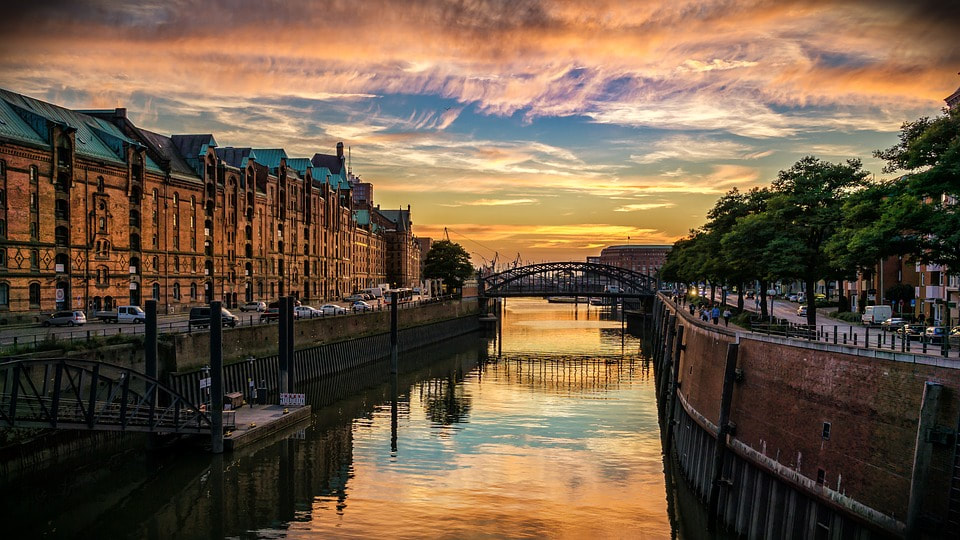Kunsthalle
Nearby the hauptbahnhof (central train station), is one of Germany's most prominent art museums. In my opinion, Berlin has the best, but Hamburg is worth the visit. Explore a mix of fine art and modernism with old and new timer artists such as Rembrandt, Goya and Canelleto, Picasso, Warhol and Kircher.
Jungfernsteig
As seen in the above image, Jungfernsteig is a waterfront promenade on the Binnenlaster. On land, explore a myriad of shops and department stores, cafes and independent shops in historical, Neoclassical buildings. The name, Jungfernsteig came about as a tradition of wealthy Hanseaten families who flaunted their unmarried daughters for eligible bachelors.
This warehouse district is a popular place to wander and admire meandering canals, graffiti bridges, historic architecture and locals living their daily life. UNESCO claimed this a world heritage site on July 5, 2015 alongside with the Kontorhaus and Chilehaus displays the largest warehouses in the world. One may consider that the name Chilehaus is a unique name for a German building. And that is true. Built in the 1920's by a local shipping magnate, Henry Sloman, one of the richest in Hamburg, made his fortune trading saltpeter with Chile. Interesting fact: the Chilehaus contains 4.8 million grey bricks.
Poggenmühlen-Brücke
Located in Speicherstadt, this bridge is a hot spot for marvelous photos of the warehouse district. The bridge itself is nothing spectacular besides being pieces of metal floating above water, but most images you see of this district come from the bridge. Sunset is a popular time where the sun reflects off the brick and stone. igniting golden rays of warm hues painted alongside the brick.
Located in the 19th Century Fischauktionhalle, is the infamous fish market. Opening on Sundays at 5:00am, the market is a mix of everyday Joes and drunkards who stumble from the Reeperbahn for some early morning grub and live music. The fish market originated in 1703 and features fresh catches from the Northern Sea as well as flowers, coffee and other market goods.
Planten un Blomen
Hamburg like most European cities are a concrete jungle dotted with several urban parks. if visiting one park, planten un blomen should mark the top of your list. The park features the Old Botanical Garden, which was planted on the city wall in 1821. The park and garden is 47-hectares featuring plenty of ponds, green space, greenhouses and botanical plantations.
The historical waterfront and piers attract locals and tourists alike. The two green-domed towers mark the 205-meter terminal between the lower port area of the fischmarkt and the reeperbahn. Landungsbrücken translates to 'landing bridges' and was once a pier for steam ships. Today, tourists take boat tours or just admire the bustling waterside.
Sankt Pauli - St. Pauli District & the Reeperbahn
A district where, sin, sex and prostitution thrives, the young and the old come here to "make a party." Alive day and night, there some bouts of normalcy exist with clothing shops, restaurants and art galleries. Although the seediness is controlled, this neighborhood has a history of dancing with the devil. As a port city, sailors have long come to the shores of Hamburg and made way to the St. Pauli District for entertainment after many months at sea. After a consistent amount of time of landlocked mermaids luring sailors of the sea in between the sheets, this is how the red light district originated.
Take the magical tour to see where the Beatles played and ignited the start of their career between 1960-1962.
One cannot visit an ancient German city without visiting one of the most prominent churches in town. Located in Altstadt, is the city's most famous Baroque church. Built in the 17th Century, the church features a 132-meter dark cupola at the top of the tower, which is visible from any part of town. The church has had its fair share of high and low moments. In 1750, the tower was struck by lightening, causing the tower to fall and crumble. The tower was also damaged by a fire in 1912, and luckily "avoided" extensive damage from World War II. The church's crypt holds the remains of 2,425 bodies including composer Carl Philipp Emanuel Bach. The 106-meter observation deck is open and features a stunning view of the harbor.
In 1911, when the Elbe tunnel opened, there was nothing like this in the world. This 426-meter tunnel was created to provide a more direct route for dock workers from St. Pauli and Landungsbrücken to the southern banks of the Elbe River. In the 1970's the tunnel opened as a tourist attraction, and today visitors and locals use the tunnel for transportation and to admire the Art Deco beauty.
This Lemon Tree article is now featured on GPSmyCity. To download this article for offline reading or travel directions to the attractions highlighted in this article, go to 12 Historical Sites in Hamburg, Germany.
Let's Connect!











 RSS Feed
RSS Feed